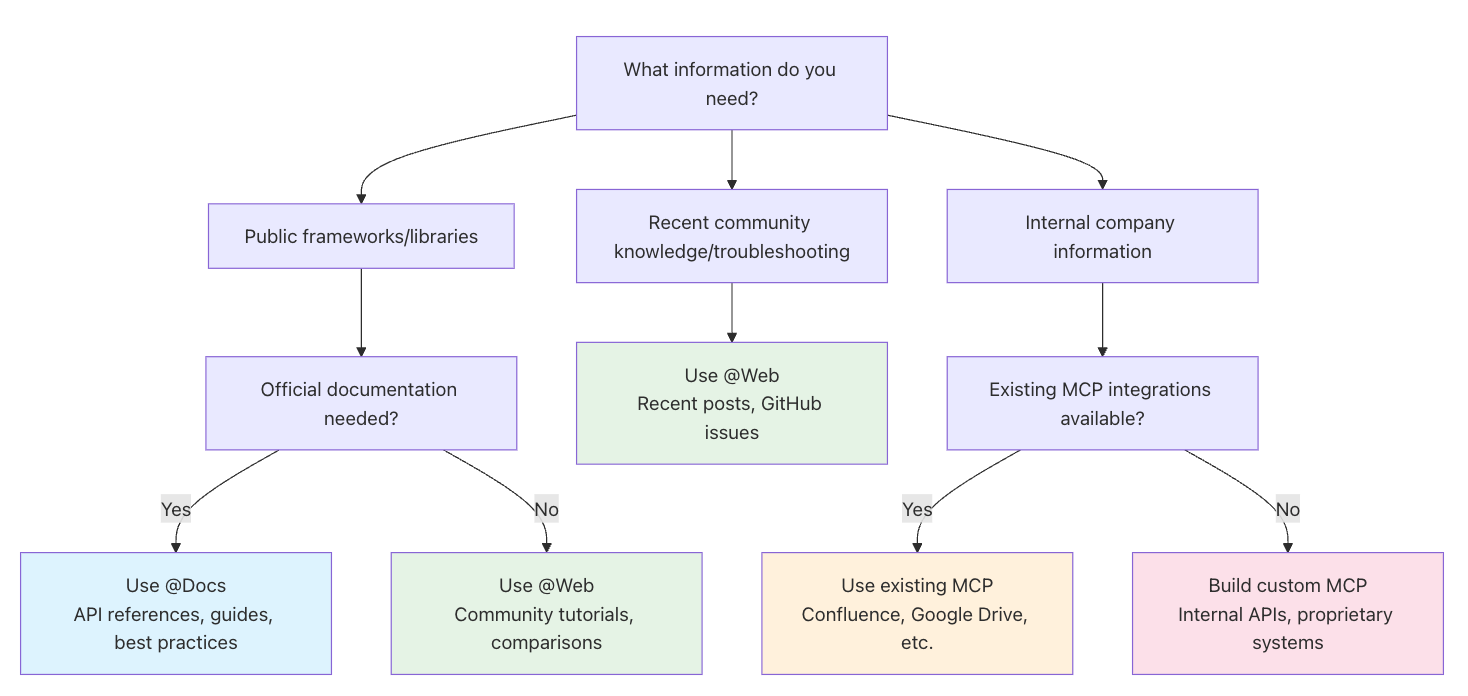[Cursor-Guide]Working with Documentation
Learn how to effectively leverage documentation in Cursor through prompting, external sources, and internal context. Improve API understanding and stay updated with current best practices.
[Cursor-Guide]Working with Documentation
原始链接: 原始链接
How to leverage documentation effectively in Cursor through prompting, external sources, and internal context
Why documentation matters
Documentation provides current, accurate context. Without it, models use outdated or incomplete training data. Documentation helps models understand things like:
- Current APIs and parameters
- Best practices
- Organization conventions
- Domain terminology
And much more. Read on to learn how to use documentation right in Cursor without having to context switch.
Model knowledge cutoff
Large language models are trained on data up to a specific point in time, called a “knowledge cutoff.” This means:
- Recent library updates might not be reflected
- New frameworks or tools may be unknown
- API changes after the cutoff date are missed
- Best practices may have evolved since training
For example, if a model’s knowledge cutoff is early 2024, it won’t know about features released in late 2024, even for popular frameworks.
Which tool should I use?
Use this decision tree to help decide which tool to use

Mental model
| Tool | Mental Model |
|---|---|
@Docs | Like browsing and reading official documentation |
@Web | Like searching for solutions on the internet |
| MCP | Like accessing your internal documentation |
Public documentation
External documentation covers publicly available information that models might have limited or outdated knowledge about. Cursor provides two primary ways to access this information.
Using @Docs
@Docs connects Cursor to official documentation from popular tools and frameworks. Use it when you need current, authoritative information about:
- API references : Function signatures, parameters, return types
- Getting started guides : Setup, configuration, basic usage
- Best practices : Recommended patterns from the source
- Framework-specific debugging : Official troubleshooting guides

Using @Web
@Web searches the live internet for current information, blog posts, and community discussions. Use it when you need:
- Recent tutorials : Community-generated content and examples
- Comparisons : Articles comparing different approaches
- Recent updates : Very recent updates or announcements
- Multiple perspectives : Different approaches to problems

Internal documentation
Internal documentation includes information specific to your organization that AI models have never encountered during training. This might be:
- Internal APIs : Custom services and microservices
- Company standards : Coding conventions, architecture patterns
- Proprietary systems : Custom tools, databases, workflows
- Domain knowledge : Business logic, compliance requirements
Accessing internal docs with MCP
Model Context Protocol (MCP) provides a standardized way to bring your private documentation and systems into Cursor. MCP acts as a thin layer between Cursor and your internal resources.
Why MCP matters:
- Models can’t guess your internal conventions
- API documentation for custom services isn’t publicly available
- Business logic and domain knowledge is unique to your organization
- Compliance and security requirements vary by company
Common MCP integrations
| Integration | Access | Examples |
|---|---|---|
| Confluence | Company Confluence spaces | Architecture documentation, API specifications for internal services, coding standards and guidelines, process documentation |
| Google Drive | Shared documents and folders | Specification documents, meeting notes and decision records, design documents and requirements, team knowledge bases |
| Notion | Workspace databases and pages | Project documentation, team wikis, knowledge bases, product requirements, technical specifications |
| Custom | Internal systems and databases | Proprietary APIs, legacy documentation systems, custom knowledge bases, specialized tools and workflows |
Custom solutions
For unique needs, you can build custom MCP servers that:
- Scrape internal websites or portals
- Connect to proprietary databases
- Access custom documentation systems
- Pull from internal wikis or knowledge bases
If you build a custom MCP server, you can also expose tools for Cursor to update the documentation
Example custom MCP server for scraping internal docs:
import { McpServer, ResourceTemplate } from "@modelcontextprotocol/sdk/server/mcp.js";
import { StdioServerTransport } from "@modelcontextprotocol/sdk/server/stdio.js";
import { z } from "zod";
import TurndownService from "turndown";
// Create an MCP server for scraping internal docs
const server = new McpServer({
name: "internal-docs",
version: "1.0.0"
});
const turndownService = new TurndownService();
// Add tool to scrape internal documentation
server.tool("get_doc",
{ url: z.string() },
async ({ url }) => {
try {
const response = await fetch(url);
const html = await response.text();
// Convert HTML to markdown
const markdown = turndownService.turndown(html);
return {
content: [{ type: "text", text: markdown }]
};
} catch (error) {
return {
content: [{ type: "text", text: `Error scraping ${url}: ${error.message}` }]
};
}
}
);
// Start receiving messages on stdin and sending messages on stdout
const transport = new StdioServerTransport();
await server.connect(transport);
Keeping docs up to date
Documentation becomes stale quickly. Cursor can help you maintain current, useful documentation by generating and updating it based on your actual code and development conversations.
From existing code
Use Cursor to create documentation directly from your codebase:
- API Documentation
Generate API documentation for this Express router, including all endpoints, parameters, and response formats

- JSDoc Comments
Add comprehensive JSDoc comments to this class, documenting all methods and their parameters

- README Creation
Create a README for this project that includes setup instructions, usage examples, and API overview

From chat sessions
Your conversations with Cursor contain valuable intent that can be turned into documentation.
- Problem Solving
Summarize our conversation about setting up authentication into a step-by-step guide for the team wiki

- Architecture
Create documentation explaining why we chose this database design, including the trade-offs we discussed

- Debugging
Write a troubleshooting guide based on this bug we just fixed, including symptoms and resolution steps

Takeaways
- Documentation as context makes Cursor more accurate and current
- Use
@Docsfor official documentation and@Webfor community knowledge - MCP bridges the gap between Cursor and your internal systems
- Generate documentation from code and conversations to keep knowledge current
- Combine external and internal documentation sources for comprehensive understanding